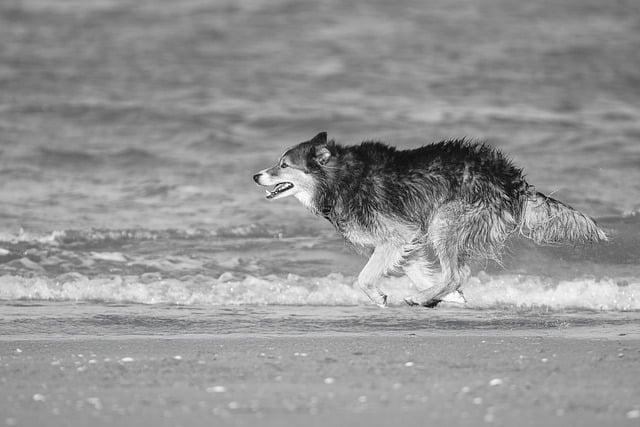In a quiet suburban neighborhood, a golden retriever named Max eagerly awaited his owner’s return. As the familiar sound of footsteps approached, Max’s tail wagged furiously, and he bounded to the door, barking with joy. This exuberant greeting is a hallmark of normal dog behavior, showcasing loyalty and affection. Dogs thrive on connection, expressing their emotions through playful antics and loving gestures. Understanding these behaviors not only strengthens our bond with them but also enriches their lives. Embrace your dog’s natural instincts; they are not just pets, but cherished family members.
Contents
- Understanding Canine Communication and Body Language
- The Importance of Play in a Dogs Daily Routine
- Socialization: Key to a Well-Adjusted Dog
- Recognizing Signs of Stress and Anxiety in Dogs
- Q&A
Understanding Canine Communication and Body Language
Understanding how dogs communicate is essential for any pet owner. Dogs express their feelings and intentions through a combination of vocalizations, facial expressions, and body language. By observing these cues, you can gain insight into your dog’s emotional state and needs. For instance, a wagging tail often signifies excitement or happiness, while a tucked tail may indicate fear or submission. Recognizing these signals can help you respond appropriately and strengthen your bond with your furry friend.
Body posture plays a crucial role in canine communication. A relaxed dog will typically have a loose body, with a slightly open mouth and soft eyes. In contrast, a dog that feels threatened may stand tall with a stiff body, raised hackles, and a fixed stare. Understanding these postures can help you identify when your dog is feeling comfortable or when they may be anxious or defensive. Paying attention to these nuances allows you to create a safer environment for your pet.
Vocalizations also provide valuable information about a dog’s emotional state. Different barks can convey various messages, from excitement to warning. For example, a high-pitched bark may indicate playfulness, while a deep, growling bark could signal aggression or discomfort. Additionally, whining can be a sign of anxiety or a request for attention. By learning to interpret these sounds, you can better understand your dog’s needs and respond effectively.
the context in which your dog displays certain behaviors is vital for accurate interpretation. A dog may exhibit different behaviors in various environments, such as at home, in a park, or around strangers. Observing how your dog interacts with their surroundings and other animals can provide further insight into their personality and comfort levels. By being attuned to these factors, you can foster a more harmonious relationship with your dog and ensure their well-being.
The Importance of Play in a Dogs Daily Routine
Engaging in play is not just a fun pastime for dogs; it is a crucial component of their overall well-being. Regular playtime stimulates a dog’s mind and body, allowing them to express their natural instincts and behaviors. This activity fosters a sense of happiness and fulfillment, which is essential for a balanced emotional state. When dogs play, they release pent-up energy, reducing the likelihood of behavioral issues such as excessive barking or destructive chewing.
Moreover, playtime serves as an excellent opportunity for socialization. Dogs are inherently social animals, and through play, they learn important skills such as communication and boundaries. Interacting with other dogs or humans during play helps them develop confidence and reduces anxiety. This social engagement is vital, especially for puppies, as it shapes their future interactions and helps them become well-adjusted adults.
Incorporating a variety of play activities into a dog’s daily routine can also enhance their physical health. Activities such as fetch, tug-of-war, or agility exercises not only provide exercise but also improve coordination and strength. Regular physical activity helps maintain a healthy weight, supports cardiovascular health, and can even prolong a dog’s lifespan. A well-exercised dog is generally happier and more relaxed, making them a joy to be around.
Lastly, playtime is an excellent way for owners to bond with their dogs. Engaging in fun activities together strengthens the human-animal relationship, fostering trust and loyalty. This connection is vital for a dog’s emotional security and can lead to a more obedient and well-behaved pet. By prioritizing play in their daily routine, owners can ensure their dogs lead enriched, happy lives, ultimately reflecting the essence of what it means to be a normal, healthy dog.
Socialization: Key to a Well-Adjusted Dog
Socialization is an essential component of raising a well-adjusted dog. It involves exposing your furry friend to a variety of environments, people, and other animals, which helps them develop the confidence and skills necessary to navigate the world around them. A well-socialized dog is more likely to exhibit positive behaviors, making them a joy to be around and a reliable companion.
When dogs are properly socialized, they learn to understand and interpret social cues from both humans and other dogs. This understanding can lead to a range of benefits, including:
- Reduced anxiety: A dog that is familiar with different situations is less likely to feel threatened or scared.
- Improved behavior: Socialized dogs are less prone to aggression and fear-based reactions.
- Enhanced adaptability: Dogs that have experienced various environments are more flexible and can adjust to new situations with ease.
- Better communication: Socialization helps dogs learn how to interact appropriately with others, reducing misunderstandings.
Engaging in regular socialization activities can significantly enhance your dog’s quality of life. Activities such as puppy classes, dog parks, and playdates with other dogs provide invaluable opportunities for your pet to learn and grow. These experiences not only help your dog develop essential social skills but also strengthen the bond between you and your pet, fostering trust and companionship.
Ultimately, investing time and effort into socializing your dog is a crucial step in ensuring they become a well-rounded member of your family. By prioritizing socialization, you are setting the foundation for a happy, confident, and well-adjusted dog who can thrive in various situations. Remember, a well-socialized dog is not just a pleasure to have around; they are also a responsible reflection of your commitment to their well-being.
Recognizing Signs of Stress and Anxiety in Dogs
Understanding the emotional landscape of our canine companions is crucial for their well-being. Dogs, much like humans, can experience stress and anxiety, and recognizing the signs early can make a significant difference in their quality of life. Observing your dog’s behavior closely can help you identify when they are feeling overwhelmed or anxious.
Common indicators of stress in dogs include:
- Excessive barking or whining: This vocalization can be a cry for help or an expression of discomfort.
- Destructive behavior: Chewing furniture or digging can signal that your dog is trying to cope with stress.
- Changes in appetite: A sudden increase or decrease in food intake may indicate emotional distress.
- Withdrawal or hiding: If your dog seeks solitude, it may be a sign that they are feeling anxious.
Physical signs are equally important to monitor. Dogs may exhibit changes in their body language that can reveal their emotional state. Look for:
- Tucked tails: A tail held low or tucked between the legs often signifies fear or submission.
- Flattened ears: Ears pinned back against the head can indicate anxiety or discomfort.
- Excessive panting: Rapid breathing, especially when not related to exercise, can be a sign of stress.
- Yawning or lip licking: These behaviors can be calming signals, indicating that your dog is feeling uneasy.
Behavioral changes can also manifest in social interactions. A normally friendly dog may become:
- Aggressive or defensive: Growling or snapping can be a response to feeling threatened.
- Overly clingy: Seeking constant attention or following you around may indicate insecurity.
- Less playful: A decrease in playfulness or enthusiasm for activities they once enjoyed can signal distress.
Q&A
-
What are typical signs of a happy dog?
A happy dog often displays behaviors such as:
- Wagging tail
- Relaxed body posture
- Playful demeanor
- Excited barking or vocalizations
These signs indicate that your dog feels secure and content in their environment.
-
How do dogs communicate with their owners?
Dogs communicate through a combination of:
- Body language
- Barking and vocalizations
- Facial expressions
- Physical touch, such as nudging or leaning
Understanding these signals is crucial for building a strong bond with your dog.
-
What is normal play behavior for dogs?
Normal play behavior includes:
- Chasing and retrieving toys
- Engaging in tug-of-war
- Play bowing (front legs stretched forward)
- Social interactions with other dogs
These activities are essential for your dog’s physical and mental well-being.
-
What should I do if my dog exhibits unusual behavior?
If your dog shows signs of unusual behavior, such as:
- Excessive barking or whining
- Aggression or fearfulness
- Changes in eating or sleeping habits
- Withdrawal from social interactions
It’s important to consult a veterinarian or a professional dog trainer to address potential underlying issues.
In understanding normal dog behavior, we empower ourselves to nurture happier, healthier pets. By recognizing their needs and instincts, we can foster stronger bonds and ensure their well-being. Embrace this knowledge for a fulfilling life together.

大家好,我是彼得潘,專業的手法身體治療師。我喜歡探索和研究各種主題,並透過與人工智慧的合作分享專業、實用、有趣的文章。我們定期進行人工審核,以確保內容的準確性。如果您發現文章中有任何不準確的地方,請隨時與我們聯繫,我們會及時糾正。您可以透過 [email protected] 與我們聯繫。



